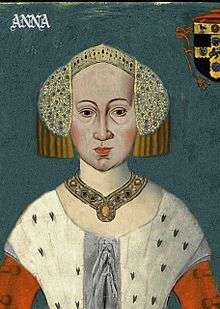Anne of Burgundy
| Anne of Burgundy | |
|---|---|
| Duchess of Bedford | |
 | |
| Born | 30 September 1404 |
| Died |
14 November 1432 (aged 28) Hôtel de Bourgogne, Paris |
| Burial |
Church of the Celestines, Paris Chartreuse de Champnol, Dijon |
| Spouse |
John of Lancaster, 1st Duke of Bedford m. 1423; wid. 1432 |
| Father | John II the Fearless, Duke of Burgundy |
| Mother | Margaret of Bavaria |
Anne of Burgundy, Duchess of Bedford (French: Anne de Bourgogne) (30 September 1404 – 14 November 1432) was a daughter of John the Fearless, Duke of Burgundy (1371–1419) and his wife Margaret of Bavaria (1363–1423).
Marriage
In June 1423 at Troyes, Anne married John of Lancaster, 1st Duke of Bedford, son of Henry IV of England by the 1423 Treaty of Amiens.[1] The marriage was meant to cement relations between England and Anne's brother Philip the Good, Duke of Burgundy.[2] This alliance was vital for continued English success in France as, in 1422, John had been appointed Regent of France, during the minority of his nephew, Henry VI of England who was seven months old at the death of his father on 31 August 1422.[3] Burgundy's antagonism with the House of Valois (which caused the Armagnac–Burgundian Civil War) had been one of the leading factors in the losses faced by the French at the hands of the English.
Death and legacy
John and Anne were happily married. Their union remained childless. Anne died on 14 November 1432 in Paris, at the Hôtel de Bourbon, adjoining the Louvre Palace. She was buried at the couvent des Célestins, while her heart was deposited at the couvent des Grands-Augustins.[4] Her tomb was designed by Guillaume Vluten and, according to one historian, "ranks among the most important Parisian effigies of the first half of the fifteenth century".[5] Of the original funerary monument at the couvent des Célestins (which was destroyed in 1849), two pieces have survived: the gisant (recumbent statue), which is at the Louvre museum, and the pleurant (mourning statue), at the Musée de Cluny, the Middle Ages museum in Paris. Bones remains, found during archeological search of the couvent des Célestins in 1847, were identified as being those of Anne, thanks to a plaque bearing her name. In 1853, these remains were taken to Saint Bégnine cathedral in Dijon, and buried in her grandfather's grave.
Anne's death signified the beginning of one of two disastrous trends in Lancastrian history. The following year, John remarried to Jacquetta of Luxembourg, but faced opposition for various political reasons in this decision from Anne's brother the Philip the Good, Duke of Burgundy. From this time on, relations between the two became cool, culminating in the 1435 peace negotiations between Burgundy and Charles VII, the exiled king of France. Later that year, a letter was dispatched to Henry VI, formally breaking their alliance.[6]
Ancestry
| Ancestors of Anne of Burgundy | ||||||||||||||||||||||||||||||||||||||||||||||||||||||||||||||||||||||||||||||||||||||||||||||||||||||||||||||||||||||||||||||||||||||||||||||||||||||||||||||||||||||||||||||||||||||||||||||||||||||||||||||||||||||||||||||||||||||||||||||||||||||||||||||||||||||||||||||||||||||||||||||||||||||||||||||||||||||||||||||||||||||||||||||||||||||||||||||||||||||||||||||||||||||||||||||||||||||||||||||||||||||||||||||||||||||||||||||||||||||||||||||||||||||||||||||||||||||||||||||||||||||||||||||||||||||||||||||||||
|---|---|---|---|---|---|---|---|---|---|---|---|---|---|---|---|---|---|---|---|---|---|---|---|---|---|---|---|---|---|---|---|---|---|---|---|---|---|---|---|---|---|---|---|---|---|---|---|---|---|---|---|---|---|---|---|---|---|---|---|---|---|---|---|---|---|---|---|---|---|---|---|---|---|---|---|---|---|---|---|---|---|---|---|---|---|---|---|---|---|---|---|---|---|---|---|---|---|---|---|---|---|---|---|---|---|---|---|---|---|---|---|---|---|---|---|---|---|---|---|---|---|---|---|---|---|---|---|---|---|---|---|---|---|---|---|---|---|---|---|---|---|---|---|---|---|---|---|---|---|---|---|---|---|---|---|---|---|---|---|---|---|---|---|---|---|---|---|---|---|---|---|---|---|---|---|---|---|---|---|---|---|---|---|---|---|---|---|---|---|---|---|---|---|---|---|---|---|---|---|---|---|---|---|---|---|---|---|---|---|---|---|---|---|---|---|---|---|---|---|---|---|---|---|---|---|---|---|---|---|---|---|---|---|---|---|---|---|---|---|---|---|---|---|---|---|---|---|---|---|---|---|---|---|---|---|---|---|---|---|---|---|---|---|---|---|---|---|---|---|---|---|---|---|---|---|---|---|---|---|---|---|---|---|---|---|---|---|---|---|---|---|---|---|---|---|---|---|---|---|---|---|---|---|---|---|---|---|---|---|---|---|---|---|---|---|---|---|---|---|---|---|---|---|---|---|---|---|---|---|---|---|---|---|---|---|---|---|---|---|---|---|---|---|---|---|---|---|---|---|---|---|---|---|---|---|---|---|---|---|---|---|---|---|---|---|---|---|---|---|---|---|---|---|---|---|---|---|---|---|---|---|---|---|---|---|---|---|---|---|---|---|---|---|---|---|---|---|---|---|---|---|---|---|---|---|---|---|---|---|---|---|---|---|---|---|---|---|---|---|---|---|---|---|---|---|---|---|---|---|---|---|---|---|---|---|---|---|---|---|---|---|---|---|---|---|---|---|---|---|---|---|---|---|---|---|---|---|---|---|---|---|---|---|---|---|---|---|---|---|---|---|---|---|---|---|---|---|---|---|---|---|---|---|---|---|---|---|---|---|---|---|---|---|---|---|---|---|---|---|---|---|---|---|---|---|---|---|---|---|---|---|---|---|---|
| ||||||||||||||||||||||||||||||||||||||||||||||||||||||||||||||||||||||||||||||||||||||||||||||||||||||||||||||||||||||||||||||||||||||||||||||||||||||||||||||||||||||||||||||||||||||||||||||||||||||||||||||||||||||||||||||||||||||||||||||||||||||||||||||||||||||||||||||||||||||||||||||||||||||||||||||||||||||||||||||||||||||||||||||||||||||||||||||||||||||||||||||||||||||||||||||||||||||||||||||||||||||||||||||||||||||||||||||||||||||||||||||||||||||||||||||||||||||||||||||||||||||||||||||||||||||||||||||||||
References
- ↑ Griffiths, p. 26.
- ↑ Neillands, p. 231.
- ↑ Weir, p. 73.
- ↑ Journal d'un bourgeois de Paris, 1405-1449, publié d'après les manuscrits de Rome et de Paris, par Alexandre Tuetey, chez Champion, Paris, 1881, pp. 289-290
- ↑ Chipps Smith, p. 39.
- ↑ Weir, Alison, The War of the Roses, Ballantine Books, 2009 Reprint (15 June 1996), p. 84. ISBN 978-0345404336
Sources
- Chipps Smith, Jeffrey (1984). "The Tomb of Anne of Burgundy, Duchess of Bedford, in the Musée du Louvre". Gesta. 23 (01): 39–50. JSTOR 766962.
- Griffiths, R.A. (2005). The Reign of King Henry VI. The History Press. ISBN 0-7509-3777-7.
- Neillands, Robin (2001). The Hundred Years War. Routledge. ISBN 0-415-26131-7.
- Weir, Alison (1996). The Wars of the Roses: Lancaster and York. London: Ballantine Books. ISBN 0-345-40433-5.
External links
-
 Media related to Anne of Burgundy at Wikimedia Commons
Media related to Anne of Burgundy at Wikimedia Commons